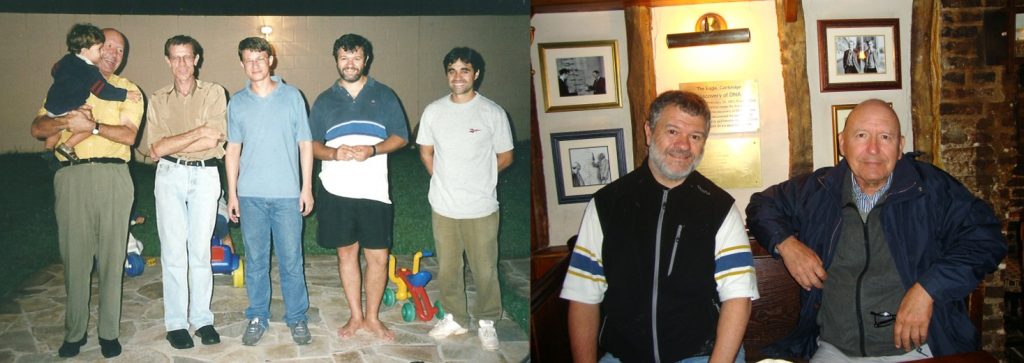About Aldo Craievich: homage, reflections and memories.

On April 24, 2023, Prof. Aldo Felix Craievich died in São Paulo, two months after his 84th birthday.
Aldo was born in the province of Santa Fe in Argentina and graduated in physics at the Instituto Balseiro in Bariloche in 1964. He later carried out his doctoral work in France under the supervision of André Guinier, a world famous researcher in the area of X-ray diffraction. In 1973, he moved to Brazil and held positions at several universities and research institutes such as the Institute of Physics and Chemistry of São Carlos (IFQSC-USP), the Brazilian Center for Research in Physics (CBPF) and the Institute of Physics at USP in São Paulo city.
There are abundant sources where it is possible to obtain detailed biographical data on Aldo – without a doubt, one of the most outstanding researchers in materials science in Brazil. But probably, Aldo will always be remembered for his contribution to the construction of the National Synchrotron Light Laboratory (LNLS) in Campinas, where he worked in the initial gestation of the project and later as Scientific Director during the construction of the first UVX storage ring. Aldo assumed responsibility for the design and construction of beamlines and, above all, the training of users for the future Brazilian source of synchrotron light.
I met Aldo personally when I moved from Switzerland to Brazil in 1993 to join the team at the incipient LNLS. The leadership of the laboratory consisted of three directors: Cylon Gonçalves da Silva, Ricardo Rodrigues and Aldo. A short conversation with them about the project to build a synchrotron with national technology starting from scratch was inspiring. What a progressive and courageous vision! I had the privilege of observing how they associated competence and originality, always looking for creative solutions adapted to the low resources and real possibilities in the Brazilian context. In addition to the material aspects, the project required the construction of a specialized technical-scientific human resources team. It is important that the new generations of professionals visualize and understand the Herculean task that was to develop and build everything, everything. An analogy would be building a skyscraper when you have to learn how to make every brick, every steel bar, every little piece. What a challenge they faced, and what a complete triumvirate! Ricardo, the creativity, engineering and physics of accelerators. Aldo, the application of synchrotron radiation, science and the training of human resources. And Cylon, weaving together different aspects like accelerator science and technology with science policy and organizing a management system for a big science laboratory. Wow, what a trio! I can tell my advisees, students, children and grandchildren, that I worked closely with them during the construction of the LNLS.!! And I didn’t bother much…
Despite his position as Director, Aldo had the humility to try to convince each researcher or student of the great opportunities that LNLS offered. He organized numerous schools in Brazil, Latin America and ICTP-Trieste, where he received students from all areas, physics, chemistry, engineering, biology, medicine, etc. This effort on an international scale is clearly reflected in the various awards he has received in other countries and in Mercosur. Perhaps the greatest recognition received by Aldo was his entry into the Brazilian Academy of Sciences in 2015, at almost 80 years old. On a very personal level, I ask myself every day: why did Aldo have to wait so long? Almost 20 years since the start of operation of the UVX, the first synchrotron in the southern hemisphere. Well… in the end justice was served, better late than never. My biggest sadness is that Aldo’s partner in the project, Ricardo Rodrigues, responsible for the design (accelerator physics) and construction (engineering, electronics, materials, etc.) of the UVX and the new synchrotron, Sirius, left in 2020 without receiving this honor. The history of Latin America shows a social and economic development with many paradoxes, such as, for example, strong urbanization without industrialization. The formation of the scientific and technological community in the country was not exempt from these peculiarities. Therefore, it is important to evolve to give more value to applied works, to the construction of real and operational equipment of small, medium or huge size, to the creation of instrumentation, sometimes advanced and sometimes just practical and cheap solutions. Innovation and industrialization, so sought after and mentioned today, will thank us. As Aldo described well in his words: “there is no division between basic and applied research, the real dichotomy is good or bad quality research”.
For us, in the Argentine community, Aldo was “el cracho”, the nickname by which he has been known since his beginnings in physics and the exact sciences. Cracho is a synonym for energy, positive energy, endless energy, energy that is contagious and makes progress, energy that transmits optimism, energy that motivates, energy that sets an example, energy that moves mountains, energy against winds and seas . The deep knowledge, the long, objective and sincere conversation, the culture, the willingness to help, to encourage people to face challenges, the example of science, humanity and ethics. This is the image I have of Aldo. I was blessed to work closely with him at the beginning of my career as a young independent scientist at LNLS. How much I learned! He was a mentor, a friend, an example, a role model.
Daniel M. Ugarte
Professor
Gleb Wataghin Institute of Physics
Unicamp

